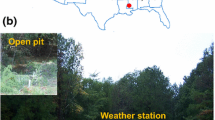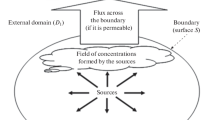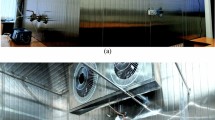Abstract
Data from two free soil gas sampling programs are evaluated for the effects of barometric pum** over time on measured soil gas volumes. One program collected data from the trapped atmosphere immediately above two hazardous waste landfill areas. Of these areas, one had extremely high soil gas emanations, whereas the other had a more modest soil gas release. The second experimental program involved the collection of free soil gas samples on a rough grid with an approximate spacing of 1.6 km over a 720-sq-km area. This reconnaissance effort was designed to establish regional soil gas background values and to establish the utility of this method as a geological map** tool in the Atlantic Coastal Plain. Methane, ethane, propane, and hydrogen data are used for this study. The data suggest that there is a predictable change in soil gas volume with a given change in barometric pressure. The rate of change is greater with large soil gas volumes in permeable soils versus lower soil gas volumes in impermeable soils; however, a simple linear relationship seems to generate a predictable curve with a margin of error of approximately 50%. Furthermore, the results of this study indicate that barometric pum** effects should be strongly considered during soil gas screening efforts at hazardous waste sites as well as in regional studies for hydrocarbon source potential map**.
Similar content being viewed by others
References
Banwell GM and Parizek RR (1988) Helium-4 and radon-222 concentrations in groundwater and soil gas as indicators of zones of fracture concentrations in unexposed rock. JGR Journ of Geophysical Research 93(Bl):355–366
Devitt DA, Evans RB, Jury WA, Starks TH, Eklund B, and Ghalsan A (1988) Soil gas sensing for detection and map** of volatile organics. USEPA Project Summary, Environmental Monitoring Systems Laboratory, Las Vegas. EPA/600/S8-87/036. 3 pp
Dickinson RG and Matthews MD (1993) Regional microseep survey of part of the productive Wyoming-Utah thrust belt. AAPG Bull 77(10): 1710–1722
Farmer CT, Milne PJ, and Zika RG (1994) Continuous hourly analysis of C2–C10 non-methane hydrocarbon compounds in urban air by GC-FID. Environ Sci Technol 28:238–245
Gregory RG and Durrance EM (1985) Helium, carbon dioxide and oxygen soil gases: Small-scale variation over fractured ground. J Geochem Explor 24:29–49
Jones VT and Pirkle RJ (1981) Helium and hydrogen soil gas anomalies associated with deep or active faults. Paper presented to the American Chemical Society, 29 March–3 April, 1981, Atlanta, GA
Pirkle RJ, Wyatt DE, Price V, and Looney BB (1992) Barometric pum**: The connection between the vadose zone and the atmosphere. In: National Ground Water Association, Proceedings of the Focus Conference on Eastern Regional Ground Water Issues. 13–15 October, 1992. Boston, pp 427–442
Pitchford AM, Mazella AT, and Scarbrough KR (1988) Soil-gas and geophysical techniques for detection of subsurface organic contamination. USEPA Project Summary, Environmental Monitoring Systems Laboratory, Las Vegas. EPA/600/S4-88/019, 6 pp
Reimer GM, Roberts AA, and Denton EH (1976) Diurnal effects on the helium concentration in soil-gas and near-surface atmosphere. USGS, Denver, CO. Open File Report 76-715, 6 pp
Richers DM, Jones VT, Matthews MD, Maciolek J, Pirkle RJ, and Sidle WC (1986) The 1983 Landsat soil-gas geochemical survey of the Patrick Draw area, Sweetwater County, Wyoming, AAPG Bull 70 (7):869–887
Richers DM, Wyatt DE, Pirkle RJ, and Price V (1994) The occurrence of wet hydrocarbon gases and bitumens in coastal plain sediments of the Central Savannah River Area, South Carolina and Georgia. Bull Assoc Petrol Geochem Explor (in press)
Rizvi SSH and Fleischacker SJ (1992) Determination of VOC's in subsurface soils using soil gas sampling: A case study. HMC Hazardous Materials Contamination March/April: 20-29
Roberts AA and Roen JB (1985) Near-surface helium anomalies associated with faults and gas accumulation in Western Pennsylvania. USGS, Reston, VA. Open File Report 85–546, 23 pp
Saunders DF, Burson KR, Brown JJ, and Thompson CK (1993) Combined geological and surface geochemical methods discovered Agaritta and Brady Creek Fields, Concho County, Texas. AAPG Bull77 (7): 1219–1240
Shonnard DR and Bell RL (1993) Benzene emissions from a contaminated air-dry soil with fluctuations of soil temperature or relative humidity. Environ Sci Technol 27 (13): 2909–2913
Thomsen KO and Joyner S (1991) Source identification and characterization using areal and vertical soil gas sampling techniques. Hazardous Materials Contamination HMC July/August: 38-41
Wyatt DE, Price V, Looney BB, Richers DM, and Pirkle RJ (1993) Soil gas waste site screening at the Savannah River Site, In: Whitfield P (convenor), Meeting the challenge, environmental remediation conference, proceedings of the ER '93 Environmental Remediation Conference, 24–29 October, 1993, Augusta, GA, pp 853–857
Author information
Authors and Affiliations
Rights and permissions
About this article
Cite this article
Wyatt, D.E., Richers, D.M. & Pirkle, R.J. Barometric pum** effects on soil gas studies for geological and environmental characterization. Geo 25, 243–250 (1995). https://doi.org/10.1007/BF00766753
Received:
Accepted:
Issue Date:
DOI: https://doi.org/10.1007/BF00766753




